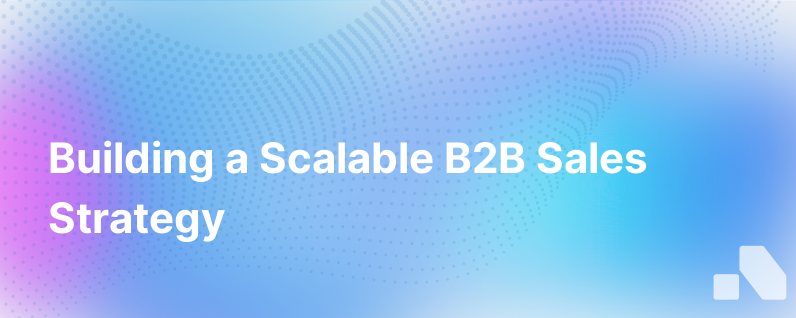How to Build a Scalable B2B Sales Strategy
Published on December 13, 2023 by Sawyer Middeleer
Successfully scaling a B2B sales strategy is akin to a tightrope walk; it requires impeccable balance between focused targeting, efficient processes, innovative tools, and continuous adaptation. In today’s hyper-competitive business landscape, a scalable sales strategy is not just nice-to-have, but a necessity for B2B organizations aiming to grow and thrive.
Understanding Your Target Market
The foundation of any scalable B2B sales strategy is a deep understanding of your target market. This begins with indentifying your Ideal Customer Profile (ICP), which shapes who you target and how you engage them. Craft your ICP with these components:
- Industry-specific needs: Does your offering resonate with particular verticals?
- Organization size: Are you targeting small businesses, mid-market companies, or enterprises?
- Revenue: What’s the typical revenue range of your ideal client?
- Geographic location: Are there specific regions where your products or services are more relevant?
- Tech stack compatibility: Is your product complementary to tools your ICP already uses?
Once your ICP is crystal clear, use it to tailor all aspects of your sales process for these target accounts. The result is a focused effort that consistently attracts the type of clients who find the most value in your offerings and are most likely to convert and expand over time.
Structuring Your Sales Process
A scalable sales process first needs a defined structure—often referred to as a sales methodology or framework—that categorizes stages from lead generation to closing the deal and beyond. Your process should include:
- Outreach methods: How will you first contact potential leads? Think cold emails, social selling, or networking events.
- Lead qualification: Use criteria such as BANT (Budget, Authority, Needs, Timeframe) to identify viable prospects.
- Pitch personalization: How will you tailor the selling points of your product or service to the specific concerns and objectives of a prospect?
- Proposal and closing techniques: Develop standard procedures for proposal creation, negotiation, and sealing the deal.
- Post-sale relationship management: Establish a follow-up system for upselling, retention, and referrals.
Sales cycles in B2B often take months and involve numerous stakeholders. A detailed, repeatable sales process enables your team to handle complex scenarios with greater consistency and confidence, increasing the likelihood of successful outcomes.
Leveraging Sales and Marketing Technology
Technology is the engine that powers scalable sales strategies. Your sales tech stack might include:
- Customer Relationship Management (CRM) platforms: CRMs are central to managing client interactions and ensuring data is shared and accessible across the organization. Systems that integrate seamlessly with other tools are preferable.
- Sales enablement tools: These provide sales teams with necessary resources such as content, playbooks, and competitive intelligence easily and at scale.
- Prospecting and lead generation tools: Leveraging artificial intelligence for prospecting can significantly scale your lead generation efforts.
- Marketing automation platforms: Use these for nurturing leads that aren’t yet ready to speak to a salesperson.
- Analytics and reporting solutions: These tools help track performance and extract actionable insights to guide strategy.
Investing in the right technological solutions can make a substantial impact on your sales team’s efficiency, allowing them to spend more time on revenue-generating activities and less on administrative tasks.
Training and Development
An often-overlooked aspect of scaling B2B sales is the progressive development of the sales team. As you grow, investing in continuous learning opportunities is essential. Consider:
- Product training: Ensure that team members are experts in the features and benefits of your product assortment.
- Sales skills workshops: Courses in consultative selling, negotiation, and emotional intelligence can refine your team's capabilities.
- Feedback loops: Develop a culture where feedback from team members is used to improve tactics and strategies continually.
Salespeople who understand the ins and outs of your offering—and how it solves client pain points—are far better equipped to articulate its value to prospects, leading to higher conversion rates.
Monitoring and Adjusting
A scalable sales strategy requires agility. Regular analysis of your sales performance will identify what's working and what isn't. Focus on metrics such as:
- Sales quota attainment: What percentage of your reps are hitting their targets?
- Conversion rates: How often are pitches or proposals turning into sales?
- Customer lifetime value (CLTV): How much value does a customer bring over the course of their relationship with your company?
- Customer Acquisition Cost (CAC): What is the average expense of acquiring a new customer including all marketing and sales costs?
By staying attuned to performance metrics, you can iterate and refine your approach over time. Adapting swiftly to market changes, customer feedback, and internal success stories will help you maintain a scalable, growth-oriented trajectory.
In Conclusion
Building and maintaining a scalable B2B sales strategy can propel an organization to new heights, but it requires diligence, foresight, and flexibility. From establishing a clear ICP and structured sales process to adopting robust technology and insisting on continuous training, each element plays a critical role. Remember to iterate based on performance data to perfect your approach. As you tailor your strategy to your unique context, these core principles will guide you towards sustainable sales success.
Sources:
- A Guide to Scaling B2B Sales %%sep%% JustCall Blog
- 9 Best B2B Sales Training Programs & Online Courses (NEW) | pclub.io
- The ultimate B2B sales tech stack
- How to Create a Scalable B2B Sales Process
- Key Elements of a B2B SaaS Strategy
- The 70/30 Rule: How to Scale Sales Team without Bloating Your Org
- The start-up and scale-up approach for B2B tech sales success | VAEKST
- 10 Essential B2B Sales Metrics To Gauge Your Performance